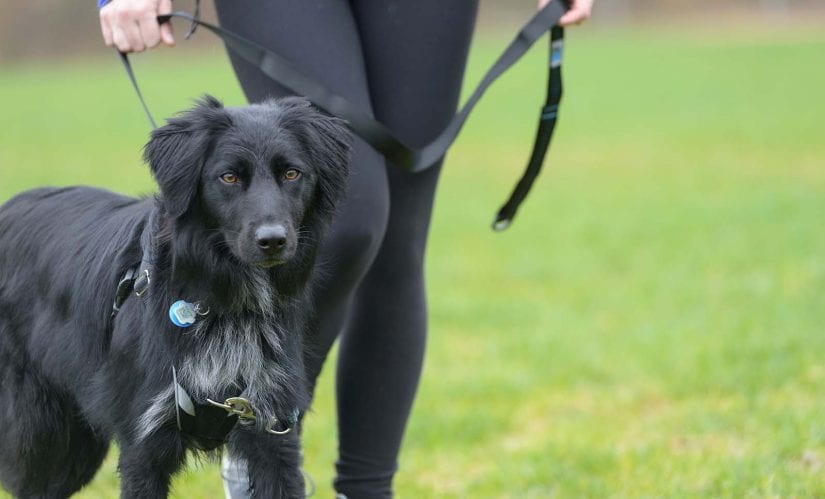With the warmer weather you might be considering how you can ramp up your daily walks with your pooch. Jogging is a fun exercise to enjoy with your dog but there are a few things to keep in mind. Below are some tips on how to jog safely with your dog this summer.

1. Get a health check
Before you hit the pavement, it’s a good idea to make sure your dog is fit enough to be your jogging buddy. Jogging can be a high intensity cardio exercise that could pose a risk for injury if your dog hasn’t been cleared by your veterinarian to participate. Some risk factors include:
- Your dog’s age. Running your dog when they’re too old or too young can result in serious health consequences for your furry friend. Running with your puppy before they are finished growing can impact her joints and muscles. When it comes to your senior dog, you want to make sure that common aging problems like osteoarthritis and heart disease are ruled out before your run.
- Your dog’s weight. Overweight dogs will struggle more with running than one who’s slim. For a dog who’s overweight it’s best to start off slow and ease them into a new exercise routine.
- Your dog’s body type. It’s important to factor in the body type of your dog; if your dog is smaller they likely can’t run as far and for as long as bigger dogs can. Dogs with heavier coats may be more prone to overheating when running, particularly in the summer. Additionally, brachycephalic dogs, or flat-faced dog breeds, like pugs, Boston terriers, French bulldogs, English bulldogs and shih tzus have difficulty getting enough air, especially in the heat, which can make running dangerous for them. These dogs are better off with a nice walk than running.
- Your dog’s fitness level. Just like people who are out of shape and need to work up to long running distances, dogs also need to adapt to running. If your dog is out of shape or not use to this type of exercise, they will need to gradually work up to that level of fitness.
2. Make your route dog-friendly
Once you’ve been given the all clear from your veterinarian, it’s time to map out a dog-friendly route. While running is a flexible activity that can be done almost anywhere, it’s best to keep the following in mind when jogging with your pooch.
- Like humans, too much exercise too soon can increase your dog’s risk for injury. So start off slow in order to build up your dog’s endurance. Maybe that means combining walking and jogging intervals, and regularly taking breaks is always a good idea.
- Refrain from jogging on hard surfaces. Pavement and roads can be tough on your dog’s joints, in addition to being too hot for your dog’s paws. If possible, stick to grass, dirt, or a softer terrain but be aware of uneven surfaces or any other hazards like rocks and holes.
- Stick to a shady and cool route. You don’t want your dog to become overheated, which is why sticking to cool and shady routes is key. A run along a lake or pond is another great idea since it’s the perfect place for your dog to stop for a dip post-run.
- Run early or run later. The earlier you run, the better, especially in the summertime before the weather really warms up. An alternative is running later when the weather starts to cool.
3. Come prepared
You’ve mapped out the most dog friendly route, and now it’s time to run your dog. Before you grab your sneakers and leash, here are some other things to consider.
- Bring water for your dog too. If you’re going for a longer run and bringing water with you, don’t forget to bring some for your furry friend too. Dogs can’t tell us when they’re dehydrated, so it’s best to take regular breaks.
- Train your dog to walk on a leash before you start running him or her. A dog who pulls on the leash is not only frustrating but can be dangerous when jogging, especially downhill. It’s also helpful if your dog knows basic commands to keep safe at intersections and around other runners.
4. Pay attention
Since your canine companion can’t talk, it’s imperative to watch out for signs or symptoms that they need to slow down or stop, or if they’re in distress. Here’s what to look out for.
- If your dog slows down and lags behind you, chances are they’re pooped. Take heed and slow down to their pace, and take a break with shade and water. Or, to be safe, you might want to call it a day and return home.
- If your dog is warm to touch, drooling, and/or vomiting, those are strong indicators of dehydration and possibly heatstroke. If you’re hot, your dog is too. Provide them immediately with water and let them rest in the shade. If your dog’s symptoms don’t go away, call your veterinarian as it could be a medical emergency.
